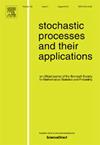On the particle approximation of lagged Feynman–Kac formulae
IF 1.2
2区 数学
Q3 STATISTICS & PROBABILITY
引用次数: 0
Abstract
In this paper we examine the numerical approximation of the limiting invariant measure associated with Feynman–Kac formulae. These are expressed in a discrete time formulation and are associated with a Markov chain and a potential function. The typical application considered here is the computation of eigenvalues associated with non-negative operators as found, for example, in physics or particle simulation of rare-events. We focus on a novel lagged approximation of this invariant measure, based upon the introduction of a ratio of time-averaged Feynman–Kac marginals associated with a positive operator iterated times; a lagged Feynman–Kac formula. This estimator and its approximation using Diffusion Monte Carlo (DMC) are commonly used in the physics literature. In short, DMC is an iterative algorithm involving particles or walkers simulated in parallel, that undergo sampling and resampling operations. In this work, it is shown that for the DMC approximation of the lagged Feynman–Kac formula, one has an almost sure characterization of the -error as the time parameter (iteration) goes to infinity and this is at most of , for . In addition a non-asymptotic in time, and time uniform bound is proved which is . We also prove a novel central limit theorem to give a characterization of the exact asymptotic in time variance. This analysis demonstrates that the strategy used in physics, namely, to run DMC with and small and, for long time enough, is mathematically justified. Our results also suggest how one should choose and in practice. We emphasize that these results are not restricted to physical applications; they have broad relevance to the general problem of particle simulation of the Feynman–Kac formula, which is utilized in a great variety of scientific and engineering fields.
滞后费曼-卡茨公式的粒子近似
本文研究了与费曼-卡茨公式有关的极限不变测度的数值逼近。这些用离散时间公式表示,并与马尔可夫链和势函数相关联。这里考虑的典型应用是与非负算子相关的特征值的计算,例如,在罕见事件的物理或粒子模拟中。我们专注于这种不变测度的一种新的滞后近似,基于引入与迭代l∈N次的正算子相关的时间平均Feynman-Kac边际的比率;一个滞后的费曼-卡茨公式。这种估计量及其用扩散蒙特卡罗(DMC)逼近的方法在物理文献中是常用的。简而言之,DMC是一种迭代算法,涉及N∈N个并行模拟的粒子或行走体,进行采样和重采样操作。在这项工作中,证明了对于滞后Feynman-Kac公式的DMC近似,当时间参数(迭代)趋于无穷时,人们几乎可以肯定地表征l1误差,并且对于κ>;0,这最多是O(exp{−κl}/N)。此外,证明了该方法在时间上具有非渐近性,且时间一致的L1−界为O(l/N)。我们还证明了一个新的中心极限定理,给出了在时变情况下精确渐近的一个表征。这一分析表明,在物理学中使用的策略,即运行N和l较小且足够长时间的DMC,在数学上是合理的。我们的结果也提示了在实践中应该如何选择N和1。我们强调,这些结果并不局限于物理应用;它们与费曼-卡茨公式的粒子模拟的一般问题有着广泛的相关性,费曼-卡茨公式被广泛应用于各种科学和工程领域。
本文章由计算机程序翻译,如有差异,请以英文原文为准。
求助全文
约1分钟内获得全文
求助全文
来源期刊

Stochastic Processes and their Applications
数学-统计学与概率论
CiteScore
2.90
自引率
7.10%
发文量
180
审稿时长
23.6 weeks
期刊介绍:
Stochastic Processes and their Applications publishes papers on the theory and applications of stochastic processes. It is concerned with concepts and techniques, and is oriented towards a broad spectrum of mathematical, scientific and engineering interests.
Characterization, structural properties, inference and control of stochastic processes are covered. The journal is exacting and scholarly in its standards. Every effort is made to promote innovation, vitality, and communication between disciplines. All papers are refereed.
 求助内容:
求助内容: 应助结果提醒方式:
应助结果提醒方式:


